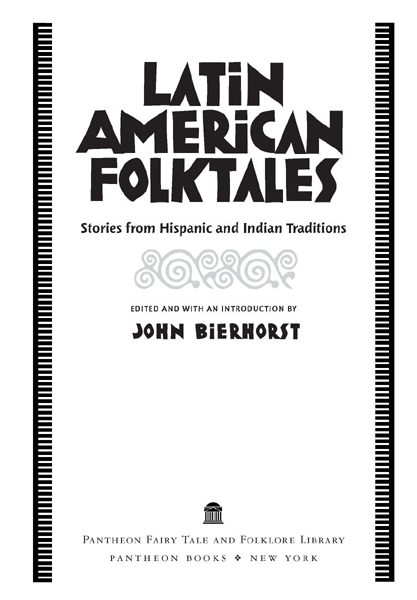Latin American Folktales


Table of Contents
PROLOGUE - EARLY COLONIAL LEGENDS
IV. THE RETURN OF QUETZALCOATL
FOLKTALES - A TWENTIETH-CENTURY WAKE
6. Don Dinero and Doña Fortuna
I. THE LETTER CARRIER FROM THE OTHER WORLD
23. The Twelve Truths of the World
24. The Mouse and the Dung Beetle
25. The Canon and the King’s False Friend
26. The Story That Became a Dream
29. Juan María and Juana María
44. The Charcoal Peddler’s Chicken
49. The Hermit and the Drunkard
50. The Noblewoman’s Daughter and the Charcoal Woman’s Son
56. How the First People Were Made
58. Adam and Eve and Their Children
II. THAT WAS THE PRINCIPAL DAY
67. The Christ Child as Trickster
68. Christ Saved by the Firefly
70. Christ Betrayed by the Magpie-jay
71. The Blind Man at the Cross
72. The Cricket, the Mole, and the Mouse
75. The Price of Heaven and the Rain of Caramels
82. My Garden Is Better Than Ever
89. Let Somebody Buy You Who Doesn’t Know You
91. Mariquita Grim and Mariquita Fair
101. A Day Laborer Goes to Work
EPILOGUE - TWENTIETH-CENTURY MYTHS
104. Why Tobacco Grows Close to Houses
107. Romi Kumu Makes the World
108. She Was Thought and Memory
110. The Beginning Life of the Hummingbird
113. The Priest’s Son Becomes an Eagle
114. The Revolt of the Utensils
115. The Origin of Permanent Death


PREFACE
The stories in this book represent the folktale tradition of Spanish-speaking America set within a frame of American Indian lore. As the scheme suggests, Latino folklore is two things at once. For the most part it is distinctly Old World, preserving medieval and even ancient story types. And yet in part it is new. That is, it has been embraced by Indo-America, which retains its own distinctive traditions while contributing a new, mixed lore of European and native elements.
The one hundred folktales at the core of this collection have been chosen to include the various European genres, ranging from the comic and the anecdotal to the heroic, the moralizing, and the religious. Familiar characters like the trickster Pedro de Urdemalas, the antagonistic two compadres, and the witch wife have been accommodated, as well as such quintessential tale types as The Bear’s Son, Blancaflor, The Three Counsels, and The Clump of Basil. To suggest the atmosphere of live performance, the stories have been sequenced in the form of an idealized
velorio,
or wake, the most frequent occasion for public storytelling in Latin America. Riddles, games (here exhibited by a genre that will be called “chain riddles”), and of course folk prayers also help pass the time at a wake. Small selections of these are added to the tales.
Consequently, care has been taken to present material that is oral. In the preface to a book of folktales this should not have to be said. Yet in the region under consideration novelists are also folklorists and the distinction between literature and folklore has often been blurred. It is easy to set aside Valentín García Sáiz’s
Leyendas y supersticiones del Uruguay
as an artist’s creation rather than the transmission of a teller’s performance, less easy to exclude the Colombian novelist Tomás Carrasquilla’s
Cuentos de Tejas Arriba.
In the case of the Costa Rican short-story writer, novelist, and political activist Carmen Lyra, the nearly two dozen folktales she recorded have been accepted by folktale scholars, and one of them is included here.
The greatest debt, however, is to the company of dedicated folklorists and anthropologists that emerged at the beginning of the twentieth century and set about the task of recording Latino folklore nation by nation. Manuel J. Andrade, for the Dominican Republic; Delina Anibarro de Halushka, for Bolivia; Paulo Carvalho-Neto, for Ecuador; Susana Chertudi, for Argentina; and Ramón Laval, for Chile, are among the names that should be mentioned. Their publications will be found listed in the bibliography; their endeavors were a kind of systematics, akin to natural history, carefully preserving, labeling, and categorizing specimens of oral literature. Without their painstaking labor a compilation of this kind, which attempts to be panoramic, would not have been possible.
African-American folklore might well have been taken into account, especially for the Caribbean area—except that it has already been included in another volume in this series, Roger D. Abrahams’s admirable
African American Folktales: Stories from Black Traditions in the
New World.
Finally, there are no translations here from the Portuguese-speaking region, though there could have been in view of the overall unity of Ibero-American lore. It can be claimed, though, that the vast territory of Brazil is beyond the scope of the present offering. The folkloric riches of Indo-, Afro-, and Luso-Brazil deserve a volume of their own.
Timothy Knab, Richard Balkin, and Altie Karper jointly decided that I should undertake this essentially Hispanic volume. I thank them for giving me the opportunity. Barbara Bader provided information at a crucial moment; and I am grateful to Susan DiLorenzo, Jean Su, Rosalie Burgher, Ruth Anne Muller, Mary Hesley, and Jeanne Elliott for aid in locating texts.
J. B.
West Shokan, New York
July 2001